History and Government of the United States
A HUMAN PERSPECTIVE Women were North America's first farmers. In all early cultures except the hunter-gatherer culture of the Southwest, women cultivated the land. They discovered which wild plants could be used as food for the family. They planted the seeds, tended the garden, harvested the crops, and prepared food for meals. Corn, beans, and […]

The United States and Canada: Climate and Vegetation
A HUMAN PERSPECTIVE A little gold and bitter cold—that is what thousands of prospectors found in Alaska and the Yukon Territory during the Klondike gold rushes of the 1890s. Most of these fortune hunters were unprepared for the harsh climate and inhospitable land of the far north. Winters were long and cold, the ground frozen. […]

Economic Geography
A HUMAN PERSPECTIVE One of the most valuable of natural resources—petroleum—wasn't always used as a source of energy. Until the world began to run on gasoline-powered machinery, oil was used for a variety of purposes. Native Americans, for instance, used “rock oil” for medicinal purposes. Egyptians used oil as a dressing for wounds. Ancient Persians […]

Urban Geography
A HUMAN PERSPECTIVE Around 4500 B.C. in Sumer, an ancient country in what today is Iraq, the city of Ur was settled. Eventually it grew to be home to as many as 34,000 people. Archaeologists believe that it was one of the first cities in the world. Within the city walls, a broad avenue led […]
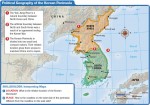
Political Geography
A HUMAN PERSPECTIVE Abdoulaye Sowe, a Senegalese farmer, chose a spot to build his new house near the Senegalese border guard's shack. He believed the guard shack was in Senegal. But long-time residents of the area told him that, before the shack was built, a guard used to sit near a tree that was considered […]

Population Geography
A HUMAN PERSPECTIVE In 1999, the world's population reached 6 billion people. To get an idea of how many people that is, consider this: If you had a million dollars in thousand dollar bills, the stack would be 6.3 inches high. If you had a billion dollars in thousand dollar bills, the stack would be […]

The Elements of Culture
BASICSA HUMAN PERSPECTIVE In an article titled “ The 100% American,” anthropologist Ralph Linton described how a typical American, in eating breakfast, had borrowed from other cultures. He has coffee, an Abyssinian plant, with cream and sugar. Both the domestication of cows and the idea of milking them originated in the Near East, while sugar […]

Soils and Vegetation
A HUMAN PERSPECTIVE In the 1870s, a settler described prairie land in Tazewell County, Illinois, as having western meadow lilies “as high as a boy's head,” rippling waves of wildflowers, and grass so dense that a man on horseback 30 yards away could not be seen. At that time, the land produced crops of grains, […]

World Climate Regions
Types of Climates World climates are generally divided into five large regions: tropical, dry, mid-latitude, high latitude, and highland. The regions are divided into smaller subregions that are described below. TROPICAL WET This subregion has little variation in temperature over the year—it is always hot, with an average temperature of 80°F. The days begin sunny […]
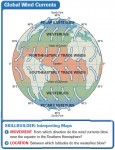
Climate
A HUMAN PERSPECTIVE Nineteenth-century fishermen along the Peruvian coast called the event El Nino—the Spanish name for the infant Jesus—because the event occurred near Christmastime. Every two to seven years, the waters off the Peruvian coast became warmer than usual, resulting in poor fishing. Eventually, 20th-century scientists studying worldwide climate changes confirmed the truth of […]

Seasons and Weather
A HUMAN PERSPECTIVE The smell of thousands of decaying corpses hung in the air in what was once the thriving seaport of Galveston, Texas. The day before, winds estimated at 130 miles per hour roared through the city. A storm surge of seawater more than 15 feet high pushed a wall of debris across the […]
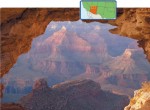
External Forces Shaping the Earth
A HUMAN PERSPECTIVE In Egypt, a seasonal dry wind is called khamsin (“fifty”) for the number of days the season occurs. During khamsin, wind-driven sandstorms kill and injure people, close businesses and airports, and strip topsoil and seed from the ground. Sandstorms are not limited to the desert areas of Africa and Southwest Asia. For […]

Internal Forces Shaping the Earth
BASICSA HUMAN PERSPECTIVE Sally Ride, America's first female astronaut, wrote the following after one of her trips into space: I also became an instant believer in plate tectonics; India really is crashing into Asia, and Saudi Arabia and Egypt really are pulling apart, making the Red Sea even wider. Even though their respective motion is […]

Bodies of Water and Landforms
A HUMAN PERSPECTIVE In July 1971, astronaut James Irwin was lifted into space on the Apollo 15 mission. As he circled the earth, he was deeply moved by the beauty of our planet. Later he wrote this: Anyone passing through our solar system would be attracted to the blue planet. They would know that the […]

The Earth Inside and Out
A HUMAN PERSPECTIVE A quick look at a world map will convince you that the continents, landmasses above water on earth, fit together like a huge jigsaw puzzle. South America and Africa are good examples. With imagination, you can see how other continents might fit together as well. The first person to suggest that the […]
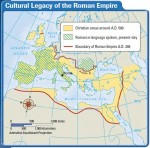
Thematic Maps
Geographers also rely on thematic maps, which focus on specific types of information. For example, in this textbook you will see thematic maps that show climate, vegetation, natural resources, population density, and economic activities. Some thematic maps illustrate historical trends, and others may focus on the movement of people or ideas. These maps may be […]
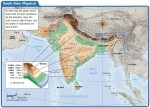
Using Different Types of Maps
PHYSICAL MAPS Physical maps help you see the types of landforms and bodies of water found in a specific area. By studying the map, you can begin to understand the relative location and characteristics of a place or region. On a physical map, color, shading, or contour lines are used to indicate elevation or altitude, […]
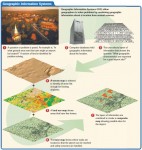
The Geographer’s Tools
A HUMAN PERSPECTIVE At noon on a sunny midsummer day, sometime around 255 B.C., Eratosthenes drove a stake into the ground at the mouth of the Nile River in Alexandria, Egypt. He then noted the angle of the shadow cast by the stake. Meanwhile at Syene (modern-day Aswan, Egypt), another person drove a stake into […]
The Five Themes of Geography
A HUMAN PERSPECTIVE Between 1838 and 1842, Captain Charles Wilkes led an American expedition to the South Pacific and Antarctica. At one stop at a South Sea island, a friendly islander drew a map on the wooden deck planks of the ship. To Wilkes's amazement, the map accurately showed the location of the Tuamotu Archipelago—a […]
The United States’ Economy
With an annual gross national product (GNP) of about $13 trillion in 2006, the United States is the world's largest and most powerful economy by a wide margin. By any measure, the country is an economic giant. In fact, it is responsible for about 30 percent of all of the world's economic production and services! To place the country's economic […]
Government and Politics
Epluribus unum is perhaps the best-known motto of the United States of America. Translated from Latin, it means “From many, one,” or “Out of many, one.” In working to achieve this goal, the nation's Founding Fathers and subsequent leaders faced a challenge of herculean dimensions. You have already learned that, from the very beginning, this land has been home to […]
People and Culture
These lines, part of a poem written by Emma Lazarus, appear on the Statue of Liberty. They offer a very appropriate introduction to this chapter on the American population. The United States has been and continues to be a grand human experiment conducted on a colossal scale. It has often been called a “country of immigrants,” people who arrived from […]
Physical Geography
Nature has blessed and in some ways cursed the United States. No country on Earth can match America’s diverse physical conditions and the resulting natural landscapes. The United States holds the distinction of being the only country that has within its territory all of the world’s climates and ecosystems (a combination of climate, natural vegetation and animal life, soils, […]
France’s Economy and Communications
France ranks fourth among countries in terms of its economy, with a gross domestic product (GDP) of around $1.5 trillion. Per-capita purchasing power is the equivalent of about U.S. $24,500 per year (compared with the U.S.'s $34,100 in 2002). AGRICULTURE France is an agriculturally favored country—60% of its land is arable and over half is cultivated—and produces prodigious quantities of […]
Population, Culture Regions, and Social Institutions
Fifty million Frenchmen can't be wrong,” goes the old saying, but there are now more than sixty million French citizens in metropolitan and overseas France. They account for 16% of the European Union's population and rank France twentieth among world countries. Approximately 75% of the country's population is urban, living in towns of 2,000 or more people. This is in […]
French History to 1830
A deep sense of the past is very much part of French character. Glorious monuments of that dramatic and creative past are revered treasures, the inheritance of the nation. Because of its respect for the past, France exceeds most other countries in its historic-preservation efforts. The history of any country, France included, is made up both of important individual events […]
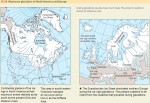
The Ice Age
Glaciation occurs when temperatures fall in regions of ample snowfall, allowing ice to accumulate and build. Although glaciation is a general term for the glacier growth and landform modification produced by glaciers, here we use it to refer to the period when continental ice sheets grow and spread outward over vast areas. When the climate warms or snowfall decreases, ice sheets become thinner and cover less […]

Ice Sheets and Sea Ice
The ice sheets of Antarctica and Greenland are huge plates of ice, thousands of meters thick in the central areas, resting on large land masses. The Greenland Ice Sheet has an area of 1.7 million km2 (about 670,000 mi2) and occupies about seven-eighths of the entire island of Greenland (Figure 17.11). The only land exposed is a narrow, mountainous coastal strip. […]
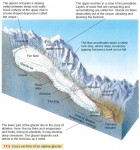
Alpine Glaciers
Figure 17.5 shows a cross section of an alpine glacier, illustrating a number of features. The glacier forms in a cirque—a high rock basin in which snow accumulates for year after year until it forms a glacier. Although the uppermost layer of a glacier is brittle, the ice beneath behaves as a plastic substance that flows slowly (Figure 17.6). An alpine […]

Glaciers
Not long ago, during the Ice Age, much of northern North America and Eurasia was covered by massive sheets of glacial ice. As a result, glacial ice has shaped large landforms in midlatitude and subarctic zones. Today, we find glacial ice in the Greenland and Antarctic Ice Sheets and in many smaller masses in high mountains. Glacial ice sheets have […]
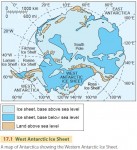
Ice Sheets, Sea Ice, and Global Warming
What effects will global warming have on the Earth's ice sheets and sea ice? In general, global climate models predict two types of changes in the Earth's ice sheets. First, warming on land and ocean will cause the melting and thinning of the edges and ice shelves of the Greenland and Antarctic ice caps. This will increase sea level. Second, warming […]
Sand Dunes and Loess
A sand dune is any hill of loose sand shaped by the wind. Sand dunes form where there is a source of sand—for example, a sandstone formation that weathers easily to release individual grains, or perhaps a beach supplied with abundant sand from a nearby river mouth. Active dunes constantly change shape under wind currents, but they must be free of […]

Wind Action
Wind plays a direct role in shaping coastal landforms, carrying sand and other sediments, and depositing them at new locations. We use the term eolian, which comes from “Aeolus,” the name of the Greek god of the winds, to describe wind-generated landforms and processes. Dunes are thus eolian landforms. Figure 16.27 is a global map showing regions where eolian processes and landforms are found. […]
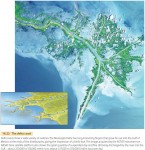
Types of Coastlines
Although every coastline is a unique creation of ocean waves acting on distinctive land masses, we can identify seven important types of coasts, shown in Figure 16.18. Coastlines of submergence are formed when the rising sea level partially drowns a coast or when part of the crust sinks. This group includes ria coasts and fiord coasts. Another group of coastlines […]
The Work of Waves and Tides
Wind, like running water, glacial action, and mass wasting, is an agent that shapes distinctive landforms. Wind can move material directly, picking up fine particles and carrying them from one place to another. Or it can act indirectly, by the action of wind-driven waves. What makes wind and breaking waves different from the other agents is that they can move material […]
Global Change and Coastal Environments
Global climate change over the remainder of the twenty-first century will have major impacts on coastal environments. The changes include increases in seasurface temperature and sea level, decreases in sea-ice cover, and changes in salinity, wave climate, and ocean circulation. What changes have already occurred? According to recent reports of the Intergovernmental Panel on Climate Change, sea level has risen about 15 […]

Fluvial Landscapes
GREAT WATERFALLS Large waterfalls are comparatively rare the world over, since the stream gradation process drains lakes and removes falls and rapids. But when tectonic activity fractures and dislocates crustal blocks, erosion may be hard pressed to keep up. As a result, we see great waterfalls on several large rivers in the African Rift Valley region. One of these is Victoria […]

The Work of Streams and Stream Gradation
Streams carry out three closely related activities—stream erosion, stream transportation, and stream deposition. Mineral materials, from bedrock or regolith, are removed from the floor and sides of the stream channel by erosion. The particles are suspended in the stream by turbulent water motion or are dissolved and held in solution. The transported particles are finally deposited on the streambed and floodplain, or […]
Slope Erosion
Most of the world's land surface has been sculpted by running water. Waves, glacial ice, and wind also carve out landforms, but for physical geographers, running water is the most important. That's because landforms made by glacial ice, wind, and waves are restricted to certain areas on the globe. We'll look at some of these other landformcreating agents in later chapters, […]
Surface Water as a Natural Resource
Fresh surface water is a basic natural resource essential to human agricultural and industrial activities. Runoff held in reservoirs behind dams provides water supplies for great urban centers, such as New York City and Los Angeles, as well as irrigation water for agriculture. We can also generate hydroelectric power from surface water where the gradient of a river is steep. […]
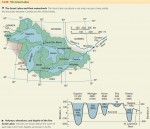
Lakes
A lake is a body of standing water with an upper surface that is exposed to the atmosphere and does not have an appreciable gradient. Ponds, marshes, and swamps with standing water can all be included under the definition of a lake. Lakes receive water from streams, overland flow, and ground water, and so they form part of drainage systems. Many […]
Streamflow and Floods
Stream discharge increases after heavy rainfall or snowmelt. But there is a delay in this increase because it takes time for the water to move into stream channels. The length of this delay depends, among other factors, on the size of the drainage basin feeding the stream. Larger drainage basins show a longer delay. It's easiest to look at the […]
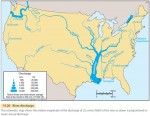
Surface Water
OVERLAND FLOW AND STREAMFLOW Runoff that flows down the land slopes in broadly distributed sheets is called overland flow. This is different from streamflow, in which the water runs along a narrow channel between banks. Overland flow can take several forms. Where the soil or rock surface is smooth, the flow may be a continuous thin film, called sheet flow. […]
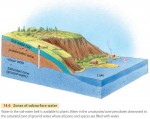
Ground Water
Water from precipitation can flow through the soil-water belt under the force of gravity. We call this flow percolation. Eventually, the percolating water reaches ground water. Ground water is the part of the subsurface water that fully saturates the pore spaces in bedrock, regolith, or soil (Figure 14.6). The top of the saturated zone is marked by the water table. Above […]
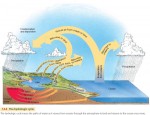
The Hydrologic Cycle Revisited
Water is essential to life. Nearly all organisms require constant access to water or at least a water-rich environment for survival. Humans are no exception. We need a constant supply of fresh water from precipitation over the lands. Some of this water is stored in soils, regolith, and pores in bedrock. And a small amount of water flows as fresh water […]

The Aral Sea
East of the Caspian Sea, astride the former Soviet republics of Kazakhstan and Uzbekistan, lies an immense saline lake—the Aral Sea. Fed by meltwaters of high glaciers and snowfields in the lofty Hindu Kush, Pamir, and Tien Shan Ranges, the lake endured through thousands of years as an oasis for terrestrial and aquatic wildlife deep in the heart of the central […]

Processes and Landforms of Arctic and Alpine Tundra
The treeless arctic and alpine tundra environment is severely cold in winter. In the tundra, soil water is solidly frozen for many months. During the short summer season, however, the surface thaws, leaving the soil saturated and vulnerable to mass wasting and water erosion. With the return of cold temperatures, the freezing of soil water exerts a strong mechanical influence on the […]
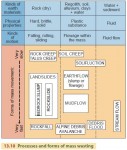
Mass Wasting
So far, we've looked at a selection of processes that alter rock chemically or break them into fragments. But what happens to these pieces once they've been loosened from the parent rock? The rock fragments are subjected to gravity, running water, waves, wind, and the flow of glacial ice. In this chapter we'll concentrate on the effect of gravity, and we'll […]
Weathering
In the last few chapters, we've looked at the Earth's crust—its mineral composition, its lithospheric plates, and the landforms created by volcanic and tectonic activity. Now let's examine the shallow surface layer in which life exists. We'll look first at how rocks are softened and how they break up. Later, we'll see how the resulting rock materials move downhill under the […]
The Madison Slide
For some 200 vacationers camping in a deep canyon on the Madison River just downstream from Hebgen Lake, not far west of Yellowstone National Park, the night of August 17, 1959, began quietly, with almost everyone safely bedded down in their tents or camping trailers. Up to a certain point, it was everything a great vacation should be—that point in time […]

Landforms and Rock Structure
Over the world's vast land area, you'll see many types of rock and rock structures. In many cases, rock structure controls the locations of uplands and lowlands, as well as the routes of streams and rivers. Rock structure affects landforms because different types of rocks are worn down by erosion at different rates. Some rock types are easily eroded, while others are […]
Earthquakes
You've probably seen the destruction wrought by e arthquakes on the television news. Californians know about this first-hand, and several other areas in North America have also experienced strong earthquakes. Earthquakes range from faint tremors to wild motions that shake buildings apart. Most earthquakes are produced by sudden slip movements along faults. These happen because rock on both sides of the fault is slowly bent […]

Tectonic Landforms
There are two basic forms of tectonic activity: compression and extension. Compression occurs when lithospheric plates are squeezed together along converging lithospheric plate boundaries, while extension happens along continental and oceanic rifting, where plates are being pulled apart. FOLD BELTS Let's start by looking at folding produced by compression. When two continental lithospheric plates collide, the plates are squeezed together at the boundary. The crust crumples, creating […]

Volcanic Landforms
Landforms are the surface features of the land—for example, mountain peaks, cliffs, canyons, plains, beaches, and sand dunes. Landforms are created by many different processes that we will describe in the remainder of this book. Geomorphology is the scientific study of the processes that shape landforms. In this chapter, we will look at landforms produced directly by volcanic and tectonic processes. […]
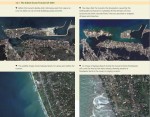
The Indian Ocean Tsunami of 2004
One of the most dangerous side effects of tectonic activity is the tsunami—a great ocean wave produced by an undersea earthquake or volcanic explosion. When a tsunami arrives at a coastline, it causes a temporary and rapid rise of sea level. Ocean waters rush landward and surge far inland, destroying coastal structures and killing inhabitants. After some minutes, the waters retreat, continuing […]
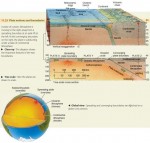
Plate Tectonics
On the globes and maps we've seen since childhood, the outline of each continent is so unique that we would never mistake one continent for another. But why are no two continents even closely alike? The answer lies in the long formation history of the Earth's surface features, which is driven by the movement of lithospheric plates. The science of lithospheric […]
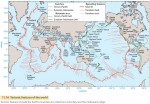
Major Relief Features of the Earth’s Surface
THE LITHOSPHERE AND ASTHENOSPHERE The major relief features of the Earth—its continents and ocean basins—were created by the movements of plates on the surface of the Earth. Geologists use the term lithosphere to describe an outer Earth shell of rigid, brittle rock, including the crust and also the cooler, upper part of the mantle (Figure 11.15). The lithosphere ranges in thickness […]

Minerals and Rocks of the Earth’s Crust
What lies deep within the Earth? Our planet has a central core with several layers, or shells, surrounding it. The densest matter is at the center, and each layer above it is increasingly less dense. THE EARTH'S INTERIOR Our planet is almost spherical, with a radius of approximately 6400 km (about 4000 mi). Its central core is about 3500 km […]
The Global Scope of Soils
How soils are distributed around the world helps to determine the quality of environments of the globe. That's because soil fertility, along with the availability of fresh water, is a basic measure of the ability of an environmental region to produce food for human consumption. We classify soils according to a system developed by scientists of the U.S. Natural Resources Conservation Service, […]
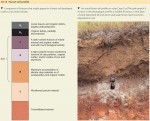
Soil Development
How do soils develop their distinctive characteristics? Let's turn to the processes that form soils and soil layers. SOIL HORIZONS Most soils have distinctive horizontal layers that differ in physical composition, chemical composition, organic content, or structure (Figure 10.12). We call these layers soil horizons. They develop through interactions between climate, living organisms, and the land surface, over time. Horizons usually […]
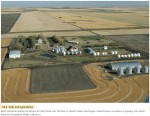
The Nature of the Soil
This chapter is devoted to soil systems. Soil is the uppermost layer of the land surface that plants use and depend on for nutrients, water, and physical support. Soils can vary greatly from continent to continent, from region to region, and even from field to field. This is because they are influenced by factors and processes that can vary widely from […]

Global Change and Agriculture
For the remainder of the twenty-first century, and probably well beyond, our global climate will change. The Earth will become warmer, especially in mid- and high latitudes. Most areas will have more precipitation, although higher temperatures will often bring more summer drought stress. Extreme events—heavy rainfalls and high winds—will be more frequent. How will global climate change impact agriculture? (Figure 10.1) In […]
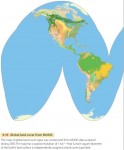
Mapping Global Land Cover by Satellite
Imagine yourself as an astronaut living on an orbiting space station, watching the Earth turn underneath you. One of the first things that would strike you about the land surface is its color and how it changes from place to place and time to time. Deserts are in shades of brown, dotted with white salty playas and the black spots and streaks of recent volcanic […]
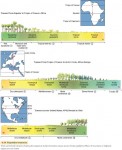
Climate and Altitude Gradients
CLIMATE GRADIENTS AND BIOME TYPES As we have seen, biomes and formation classes change along with climate. Figure 9.34 shows three continental transects that illustrate this principle. The upper transect stretches from the Equator to the Tropic of Cancer in Africa. Across this region, climate ranges through all four low-latitude climates: wet equatorial, monsoon and trade-wind coastal, wet-dry tropical , […]

Desert and Tundra Biomes
DESERT BIOME The desert biome includes several formation classes that are transitional from grassland and savanna biomes into vegetation of the arid desert. Our map of the desert biome (Figure 9.28) recognizes two basic formation classes: semidesert and dry desert. Semidesert is a transitional formation class found in a wide latitude range—from the tropical zone to the midlatitude zone. It is […]

Savanna and Grassland Biomes
SAVANNA BIOME The savanna biome is usually associated with the tropical wet-dry climate 3 of Africa and South America. Its vegetation ranges from woodland to grassland. In savanna woodland, the trees are spaced rather widely apart because there is not enough soil moisture during the dry season to support a full tree cover. The open spacing lets a dense lower layer […]
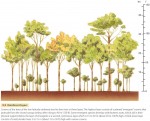
Forest Biome
Within the forest biome, we can recognize six major formations: low-latitude rainforest, monsoon forest, subtropical evergreen forest, midlatitude deciduous forest, needleleaf forest, and sclerophyll forest. Ecologists sometimes recognize three principal types of forest as separate biomes, based on their widespread nature and occurrence in different latitude belts: low-latitude rainforest, midlatitude deciduous and evergreen forest, and boreal forest. LOW-LATITUDE RAINFOREST Low-latitude rainforest, found in […]
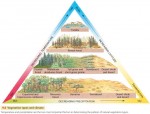
Terrestrial Ecosystems — The Biomes
For humans, ecosystems are great natural factories producing food, fiber, fuel, and structural material. These useful products are manufactured by organisms using energy from the Sun, and we harvest that energy by using these ecosystem products. The products and productivity of ecosystems depend on their climate. Where temperature and rainfall cycles permit, ecosystems provide a rich bounty. Where temperature or rainfall cycles restrict […]
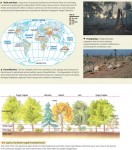
Natural Vegetation
Over the last few thousand years, human societies have come to dominate much of the land area of our planet. We've changed the natural vegetation—sometimes drastically—of many regions. What exactly do we mean by natural vegetation? Natural vegetation is a plant cover that develops with little or no human interference. It is subject to natural forces, storms, or fires that […]

Exploitation of the Low-Latitude Rainforest Ecosystem
Many of the world's equatorial and tropical regions are home to the rainforest ecosystem. This ecosystem is perhaps the most diverse on Earth, possessing more species of plants and animals than any other. Very large tracts of rainforest still exist in South America, south Asia, and some parts of Africa. Ecologists regard this ecosystem as a genetic reservoir of many species […]

Biodiversity
Today, global biodiversity—the variety of biological life on Earth—is rapidly decreasing. Two out of every five species on the planet that have been assessed by scientists face extinction, according to the International Union for Conservation of Nature and Natural Resources (Figure 8.37). Our species, Homo sapiens, has ushered in a wave of extinctions unlike any that has been seen for millions of years. In the last […]

Historical Biogeography
Thus far, we've looked at ecological processes that produce biogeographic patterns at local and regional spatial scales. We now turn to patterns at continental and global scales that develop over longer time periods. Historical biogeography focuses on how these spatial distribution patterns arise over space and time through four key processes: evolution, speciation, extinction, and dispersal. EVOLUTION An astonishing number of […]
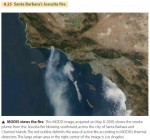
Remote Sensing of Fires
Wildfires occur frequently on the Earth's land surface, and biomass burning has important effects on both local and global ecosystems. Biomass burns inefficiently, releasing not only carbon dioxide and water, but also a number of other greenhouse gases that absorb outgoing longwave radiation and enhance the greenhouse effect. Aerosols are another by-product of inefficient combustion that can effect atmospheric processes. Burning mobilizes such nutrients as nitrogen, phosphorus, and sulfur […]
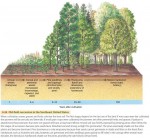
Ecological Succession
Plant and animal communities change through time. Walk through the country and you'll see patches of vegetation in many stages of development—from open, cultivated fields through grassy shrublands to forests. Clear lakes gradually fill with sediment and become bogs. We call these changes—in which biotic communities succeed one another on the way to a stable end point—ecological succession. In general, succession forms the most complex community of organisms possible, […]
Ecological Biogeography
We've seen how energy and matter move through ecosystems. But if we want to fully understand ecosystems, we'll also need to look at ecological biogeography, which examines the distribution patterns of plants and animals from the viewpoint of their physiological needs. That is, we must examine how the individual organisms of an ecosystem interact with their environment. From fungi digesting organic matter […]

Energy and Matter Flow in Ecosystems
This chapter is the first of two chapters that look at biogeography. Biogeography focuses on the distribution of plants and animals—the biota—over the Earth. It identifies and describes the processes that influence plant and animal distribution patterns. Ecological biogeography looks at how the distribution patterns of organisms are affected by the environment. Historical biogeography focuses on how spatial distribution patterns of organisms arise […]
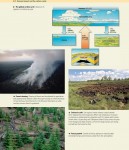
Human Impact on the Carbon Cycle
Carbon is an element that is abundant at the Earth's surface and is also essential for life. Carbon cycles continuously among the land surface, atmosphere, and ocean in many complex pathways. However, these flows are now strongly influenced by human activity. The most important human impact on the carbon cycle is the burning of fossil fuels, which releases carbon dioxide (CO2) into […]

High-Latitude Climates (Group III)
By and large, the high-latitude climates are climates of the northern hemisphere, occupying the northern subarctic and arctic latitude zones. But they also extend southward into the midlatitude zone as far south as about the 47th parallel in eastern North America and eastern Asia. One of these, the ice sheet climate, is present in both hemispheres in the polar zones. The […]
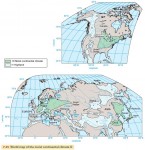
Midlatitude Climates (Group II)
The midlatitude climates almost fully occupy the land areas of the midlatitude zone and a large proportion of the subtropical latitude zone. They also extend into the subarctic latitude zone, along the western fringe of Europe, reaching to the 60th parallel. Unlike the lowlatitude climates, which are about equally distributed between northern and southern hemispheres, nearly all of the midlatitude climate area […]
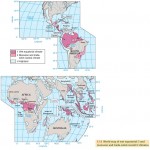
Low-Latitude Climates (Group I)
The low-latitude climates lie for the most part between the Tropics of Cancer and Capricorn, occupying all of the equatorial zone (10° N to 10° S), most of the tropical zone (10–15° N and S), and part of the subtropical zone. The low-latitude climate regions include the equatorial trough of the intertropical convergence zone (ITCZ), the belt of tropical easterlies (northeast and […]
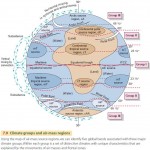
Climate Classification
Mean monthly values of air temperature and precipitation can describe the climate of a weather station and its nearby region quite accurately. To study climates from a global viewpoint, climatologists classify these values into distinct climate types. This classification requires developing a set of rules to use in examining monthly temperature and precipitation values. By applying the rules, a climatologist can use […]
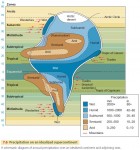
Temperature and Precipitation Regimes
Many parts of the world show distinctive patterns of monthly temperature and precipitation, usually related to latitude and location. These patterns are referred to as regimes of temperature and precipitation. TEMPERATURE REGIMES Figure 7.5 shows annual cycles of air temperature for different temperature regimes. The equatorial regime (Douala, Cameroon, 4° N) is uniformly very warm, with temperatures close to 27°C (81°F) […]

Factors Controlling Climate
Climate is the average weather of a region. The primary driving force for weather is the flow of solar energy received by the Earth and atmosphere. Because that energy flow varies on daily cycles with the planet's rotation and on annual cycles with its revolution in orbit, temperature and precipitation also vary on daily and annual cycles. However, climate includes […]

Drought in the African Sahel
One of the Earth's more distinctive climates is the wetdry tropical climate . Here, the weather is largely dry for much of the year, but there is a rainy season of a few months duration in which most of the annual rainfall occurs. Precipitation during the wet season is quite variable, ranging from little or none to torrential rainfalls that produce […]
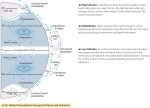
Poleward Transport of Heat and Moisture
As we saw in Chapter 5, the general circulation of the atmosphere and oceans is driven by the difference in solar heating between low and high latitudes. This general circulation, combined with jet stream disturbances in the midlatitudes, serves to redistribute heat and moisture from the Equator to the poles in the process of poleward heat transport. Figure 6.30 shows the various mechanisms by which this […]
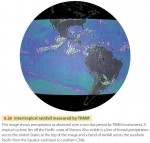
The Tropical Rainfall Monitoring Mission
In November of 1997, NASA and the Japanese Space Agency launched a joint satellite mission with the goal of monitoring rainfall in the tropical and equatorial regions of the world—the Tropical Rainfall Monitoring Mission (TRMM). Its operational objective is to provide more information about where and when intertropical convective precipitation occurs, particularly over oceans, which are not monitored by weather stations and rain gauges. The mission is also designed […]
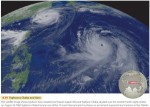
Tropical and Equatorial Weather Systems
So far, we have discussed weather systems of the midlatitudes and poleward. Weather systems of the tropical and equatorial zones show some basic differences from those of the midlatitudes. Upper-air winds are often weak, so air-mass movement is slow and gradual. Air masses are warm and moist, and different air masses tend to have similar characteristics, so fronts are not as clearly defined. Without the […]
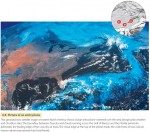
Midlatitude Anticyclones and Cyclones
Air masses are set in motion by wind systems—typically, masses of air moving in a spiral. Air can spiral inward and converge in a cyclone, or spiral outward and diverge in an anticyclone. Most types of cyclones and anticyclones are large features spanning hundreds to thousands of kilometers that move slowly across the Earth's surface, bringing changes in the weather as […]
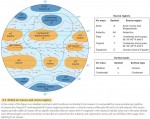
Air Masses
We know that the Earth's atmosphere is in constant motion, driven by the planet's rotation and its uneven heating by the Sun. The horizontal motion of the wind moves air from one place to another, allowing air to acquire characteristics of temperature and humidity in one region and then carry those characteristics into another region. In addition, as winds at the […]
Cloud Cover, Precipitation, and Global Warming
Clouds are so common we don't think much about them. But they can have a large impact on climate. How would global climate be influenced by an increase in clouds and precipitation? Global temperatures have been rising over the last 20 years. Satellite data show a rise in temperature of the global ocean surface of about 1°C (1.8°F) over the past […]
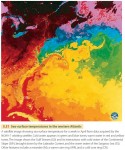
Ocean Circulation
Just as there is a circulation pattern to the atmosphere, there is also a circulation pattern to the oceans that it is driven by differences in density and pressure acting along with the Coriolis force. Pressure differences are created in the water when the ocean is heated unequally, because warm water is less dense than cold water. These pressure differences induce […]

Winds Aloft
We've looked at airflows at or near the Earth's surface, including both local and global wind patterns. But how does air move at the higher levels of the troposphere? Like air near the surface, winds at upper levels of the atmosphere move in response to pressure gradients and are influenced by the Coriolis effect. How do pressure gradients arise at […]

Global Wind and Pressure Patterns
For simplicity, let's begin by looking at surface winds and pressure patterns on an ideal Earth that does not have oceans and continents, or seasons (Figure 5.16). Hadley cells are key to an understanding of the wind patterns on our ideal Earth. These form because the Equator is heated more strongly by the Sun than other places, creating thermal circulations. Air […]
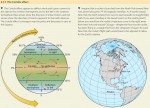
Cyclones and Anticyclones
THE CORIOLIS EFFECT We have seen that the pressure gradient force moves air from high pressure to low pressure. For sea and land breezes, which are local in nature, this pushes wind in about the same direction as the pressure gradient. But on global scales, the direction of air motion is more complicated. The difference is caused by the Earth's rotation, through the Coriolis effect (Figure 5.13). The Coriolis effect […]
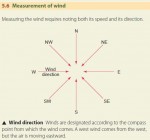
Local Wind Patterns
Wind is defined as air moving horizontally over the Earth's surface. Air motions can also be vertical, but these are known by other terms, such as updrafts or downdrafts. Wind direction is identified by the direction from which the wind comes—a west wind blows from west to east, for example. Like all motion, the movement of wind is defined by its […]
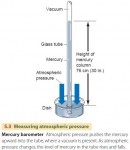
Atmospheric Pressure
We live at the bottom of a vast ocean of air—the Earth's atmosphere. Like the water in the ocean, the air in the atmosphere is constantly pressing on the Earth's surface beneath it and on everything that it surrounds. The atmosphere exerts pressure because gravity pulls the gas molecules of the air toward the Earth. Gravity is an attraction among all […]
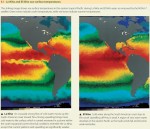
El Nino
At irregular intervals of about three to eight years, a remarkable disturbance of ocean and atmosphere occurs in the equatorial Pacific region—El Nino. Its name comes from Peruvian fishermen, who refer to the Corriente del Nino or the “Current of the Christ Child,” to describe an invasion of warm surface water once every few years around Christmas time that greatly depletes their […]

Air Quality
Most people living in or near urban areas have experienced air pollution first hand. Perhaps you've felt your eyes sting or your throat tickle as you drive an urban freeway. Or you've noticed black dust on window sills or window screens and realized that you are breathing in that dust as well. AIR POLLUTANTS Air pollution is largely the result […]
Tornadoes
A tornado is a small but intense vortex in which air spirals at tremendous speed. It is associated with thunderstorms spawned by fronts in the midlatitudes of North America. Tornadoes can also occur inside tropical cyclones (hurricanes). TORNADO CHARACTERISTICS A tornado, seen in Figure 4.32, appears as a dark funnel cloud hanging from the base of a dense cumulonimbus cloud. At […]
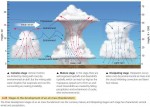
Thunderstorms
A thunderstorm is any storm that produces thunder and lightning. At the same time, thunderstorms can also produce high winds, hail, and tornadoes. They are typically associated with cumulus clouds that indicate the presence of rising, unstable air. It is this rising motion that produces the characteristic rainfall and lightning that accompany thunderstorms. Thunderstorms can range from fairly isolated, short-lived storms, sometimes called […]